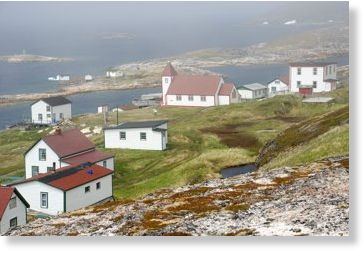
Battle Harbour Labrador, in July 2009
Canada - One of the bittersweet aspects of living in Newfoundland is that while people cherish their communities, they're often forced to leave them.
It's always been that way and it marks Newfoundland and Labrador's history deeply.
As the
National Post reports, the village of Little Bay Islands now finds itself wrestling with a tough decision: agree to a provincially funded resettlement plan that would pay remaining residents tens of thousands of dollars to leave, or stay to watch their economically bereft community inevitably die.
Despite the riches that offshore oil and gas development have brought in recent years, life on The Rock remains tenuous. Governments have struggled with the issue since before it joined Confederation in 1949.
In the 1960s, a federal-provincial
resettlement program depopulated Newfoundland's outports. Many were demolished so people wouldn't return but the province still is dotted some 300 abandoned settlements. Newfoundland blogger and travel writer Candice Walsh sees their tourism potential.
"About 307 communities were abandoned between 1947 and 1975, relocating 28,000 people," the St. John's writer says. "The real result? There was a lack of jobs in the receiving areas, and many people felt they had been forced to leave their homes by pressure from the government and their communities.
"The majority were not happy with moving. This is an incredibly significant part of Newfoundland history, still reflected in our current culture and 'collective psyche.' "
There's an irony in those beautifully filmed Newfoundland and Labrador commercials showing happy people outside their colourful homes on a windswept coastline. Many villages like that are abandoned and rotting.
Walsh says those commercials make her weepy.
"I also seem to have weird fascination with decaying and falling-down houses," she writes. "My goal is to one day hire someone to sail me around to some settlements where old buildings still stand, camping out under stars, so I can photograph and tell a story."
The tourism web site
Coastal Adventures also references the province's abandoned settlements but I'm not sure I'd make a special trip to explore them. Newfoundland's other charms, especially the hospitality of its people, seem more attractive than picking over the bones of dead towns. It's like visiting some Old West ghost town; the novelty of decaying houses and overgrown streets wears off after a while.
Back at Little Bay Islands, the last thing the remaining 72 residents (down from 800 when its crab-processing plant was still operating) are probably thinking is what a quaint little tourist attraction their empty homes will be some day.
They're remembering what a wonderful place it was when it thrived.
"We all know our little community's dying," one resident told the
Post. "One time, I'd say there was probably seven or eight stores here; you could go and buy whatever you wanted. Now, you can't even get a soft drink."

Why?